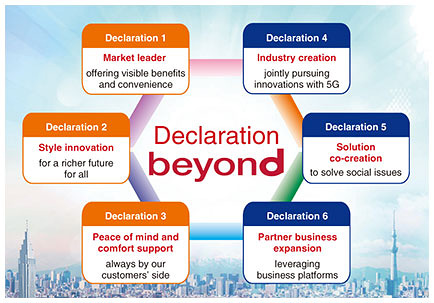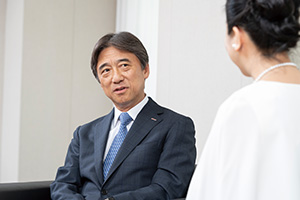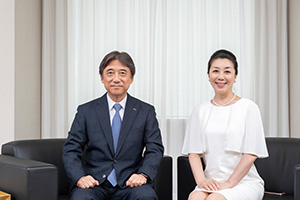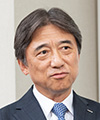Medium-Term Strategy 2020 “Declaration beyond” aiming for sustainable growth
—Mr. Yoshizawa, NTT DOCOMO is said to be undergoing a business transformation. How are things going?
Business operations are on the right track. Competition in the mobile market is becoming increasingly severe, so we are working day in and day out to gain the favor of our customers. For example, customer satisfaction is high with the “docomo with” billing plan, and our subscriber base is increasing steadily. However, we cannot become complacent with these results. Our Medium-Term Strategy 2020 “Declaration beyond” announced in April 2017 is aimed at establishing a solid business platform while we earnestly address the ever-changing needs of society and return more value to customers (Fig. 1). We will continue to challenge new frontiers with an eye to 2020 and beyond. We aim to create a richer future with fifth-generation mobile communications systems (5G) by providing surprising and exciting services exceeding our customers’ expectations and by co-creating new value with our business partners. At present, we are steadily moving into the execution phase.

Fig. 1. Medium-Term Strategy 2020 “Declaration beyond.”
As its services expand beyond communications, NTT DOCOMO is redefining the meaning of “customer.” Up to now, we have focused all of our energy on increasing the number of our mobile subscribers, but with the penetration rate of mobile phones now exceeding 100% in Japan, we are making a shift from a customer foundation based on “subscribers” to one based on “membership.” Here, a “member” is someone who uses NTT DOCOMO services regardless of whether that person is an NTT DOCOMO mobile subscriber. In other words, we seek to maximize the value that we can offer, even to customers who may be mobile subscribers of other companies but who use NTT DOCOMO services such as “d POINT” (loyalty points program), “d CARD” (credit card), and “dmarket” (content delivery portal).
Specifically, as stated in “Declaration 1: Market leader” of “Declaration beyond,” we aim to lead the market in providing benefits, convenience, and surprise, by integrating and enhancing services, billing plans, and loyalty points programs. Similar ecosystems already exist in other companies’ services, but we aim to expand the number of “d POINT” partners to more than 300 companies by fiscal year 2020 and to develop “d POINT” as one of Japan’s largest loyalty points programs.
We are also busy with a variety of initiatives in relation to artificial intelligence (AI). For example, in May 2018 we launched the “my daiz” AI agent service—one of the nine challenges proclaimed in “Declaration 2: Style innovation.” On assuming the office of president, I announced my goal to achieve the ultimate personal agent that blends in perfectly with people’s lives, and I can say that “my daiz” is truly the precursor of this agent. This service anticipates behavior using information obtained from a customer’s smartphone operations and assists the customer in choosing actions that make for a smoother day. For example, “my daiz” can anticipate and provide information that the customer will likely need such as information on a delay in the running of a train that the customer always uses. Looking forward, we want to be able to anticipate customer behavior to make personalized and optimized proposals. To this end, we continue to refine AI, which takes on the role of a “mind,” to provide surprise and excitement beyond the customer’s expectations.
In addition, we plan to use 5G with augmented reality, virtual reality, AI, and the Internet of Things (IoT) to achieve “experience innovation,” “life style innovation,” and “work style innovation.” For example, by partnering with content providers and broadcasters, we plan to place multiple cameras at a venue and deliver a live program such as a sports event and concert by 4K/8K video using NTT’s “Kirari!” immersive telepresence technology and other video processing technologies. In this way, we hope to provide customers in remote locations with the sense of reality as if they were present at the venue. High-presence, high-resolution, wide angle, and multiple simultaneous transfers constitute an area that makes full use of 5G. We plan to exploit these features to provide customers with truly exciting experiences.
—It appears that many initiatives are being launched that will transform the world.
That’s true, and 5G in particular will be a driving force. With the aim of offering the 5G experience sooner, NTT DOCOMO will deliver a “pre-service” at the stadiums that will be used in the Rugby World Cup to be held in September 2019 in Japan. Building on these achievements, we plan to commence commercial services of 5G in the spring of 2020.
As stated in “Declaration 4: Industry creation,” NTT DOCOMO will contribute to the further development of society and industry by leveraging the 5G features of high speed and large capacity, low latency, and massive device connectivity to expand the possibilities for business in collaborations with partner companies. I believe that 5G will be a major pillar of our digital transformation, which will lead to (1) improved business operations, that is, improved productivity, (2) radically enhanced user-interface/user-experience designs, and (3) the creation of totally new, revolutionary services. We aim to achieve these transformations through 5G.
I remember well, when 3G and LTE (Long-Term Evolution) services were being launched, it was often said, “Are these high-speed communications really necessary?” But as it turned out, the sudden spread of social media, streaming video, and smartphones have today made those high-speed communications an absolute necessity. The approach taken here was to build the network first and to catch up with services later. In the case of 5G, however, our goal is to provide 5G-era services from day one, that is, to launch both the 5G network and 5G services at the same time. For this reason, co-creation with a wide range of partners is essential.
To facilitate this co-creation of new 5G-era services with diverse partners, we provide the DOCOMO 5G Open Partner Program at no charge. More than 1800 companies and organizations have already come to participate in this program, which features workshops that include lectures and lively discussions among partners on creating new 5G services. We also provide the DOCOMO 5G Open Lab technology-testing environment in which 5G experimental base-station equipment can be used without charge. One site was set up in Tokyo in April and another in Osaka in September, and one is scheduled to open in Okinawa in December.
Furthermore, with the aim of deploying specific 5G services, we are conducting a wide variety of trials—more than 70—with partners at 5G Trial Sites that have been set up in the Tokyo Waterfront City district and Tokyo Skytree® neighborhood. We expect that promoting co-creation with diverse partners at an early stage in this way will support the rapid creation of new services in the 5G era.
Let me give you two examples of these trials. The first trial involves the remote operation of construction machinery, and we are conducting this jointly with Komatsu Ltd. In this trial, we mount 5G terminals on construction machinery such as hydraulic excavators and bulldozers and have a remote operator control the machinery while watching video of it via 5G. Through this trial, we are studying the feasibility of performing accurate and efficient on-site work and work management from a remotely located office by checking on-site conditions in real time through NTT DOCOMO 5G connections.
The second trial entails remote medical services that we conducted in collaboration with the Wakayama Prefecture and Wakayama Medical University. In this trial, we first transmitted images of ultrasound-image diagnostic apparatus (echo) and MRI (magnetic resonance imaging) systems, or 4K images of the affected area of the patient’s body to the university’s Regional Medical Support Center. We then asked a medical specialist at the university to make a diagnosis via 4K teleconference that could support medical treatment at the rural clinic. In this way, we are trying to resolve disparities in the provision of healthcare services, one of the major social issues in the country.

Value creation arises from co-creation with partners
—Changes are also taking place at construction sites, and the workers involved could be changing.
That’s right. The on-site working environment in civil engineering and construction has long been described as “3K,” referring to the three Japanese words kitsui, kitanai, and kiken (hard, dirty, and risky). I’ve heard that the driver’s seat in some models of bulldozers is not equipped with air conditioning. For on-site work during hot and humid summers and at accident scenes or hazardous zones that people should not enter, it will become possible to use a camera in place of the human eye and transmit high-resolution video by 5G to a remote monitor. This capability will enable remote operation of machinery in real time as if the operator were at the actual site.
We can also consider that the skillful use of big data can be applied to solve social problems. For example, we are implementing the LANDLOG open IoT platform to improve productivity in the construction industry. LANDLOG uses IoT technology to collect data at construction sites on dump trucks that carry earth and on worker movements and other details. It will then analyze that data using AI so that on-site operations can be optimized and work efficiency improved. Our goal here is to achieve process innovation at construction sites.
Additionally, as stated in “Declaration 5: Solution co-creation,” we are working to solve social problems and revitalize regional economies in primary industries, education, mobility, and other fields. This is expected to stimulate growth in Japan and create a richer society.
I can give you some examples of applications in primary industries such as agriculture and the fishing industry. In agriculture, we are working to reduce the manual labor associated with the day and night monitoring of rice paddies by applying a system that measures the temperature and level of water in a paddy and visualizes such data on the farmer’s smartphone screen. In the fishing industry, we are working on the ICT (information and communication technology) Buoy solution system that measures ocean data such as water temperature and salt concentration and visualizes those data on smartphones. This system makes it possible to reduce the risks of relying only on human experience and know-how and to complement such know-how with data, thereby improving quality and efficiency in the cultivation of seaweed and oysters.
Meanwhile, while it was only a short time ago that services such as self-driving cars were thought to be something only seen in movies, we now know that such unbelievable services may be achievable in the real world through technical innovation. It would not be possible, however, to switch all cars from being ordinary ones to self-driving ones all at once. Whatever the matter may be, it’s simply not feasible to make a complete change at the same point in time. Likewise, in our initiatives for construction sites, agriculture, and the fishing industry, it is essential that we apply a plan-do-check-act (PDCA) cycle any number of times while reflecting the best idea at each time. Innovation never ends. I believe that repeating the PDCA cycle is one way of fostering innovation.
—“Repetition” appears to be a straightforward approach.
Yes it is, and management as well undergoes cycles of improvement. Here, one must take a hard look at the results to date, but there is no guarantee that revenues will increase by using the same method as before. New things must always be incorporated, and you yourself must change.
At the same time, even if the economy and social conditions should be undergoing substantial change, the reason for NTT DOCOMO’s existence does not change, which I believe to be the continuous provision of new value to customers and society. At present, however, what we can do by ourselves is limited. Accepting ideas and technologies possessed by a variety of partner companies and organizations is what I call receptivity, and combining the strengths of all parties involved to create totally new value is what I recognize to be open innovation, or in other words, co-creation.
We call this initiative +d (plus d), which involves an effort to achieve positive results for both a partner
and NTT DOCOMO. The +d initiative is already making progress in diverse fields. NTT DOCOMO has extensive business assets such as its mobile network, membership base, and secure settlement system. Combining these assets with our partners’ assets should generate a “chemical reaction” from which we can create new business useful to our partners and co-create new social value.
In today’s world, value creation will be limited if we rely only on the abilities of individuals or single companies. We must therefore collaborate with partners and bring out ideas. As part of this +d initiative, we are trying to change the procedure for product and service development used in the past, where salespeople meet with customers and listen to what they have to say and pass that information on to those in charge of technology for reflection in development. When salespeople talk to customers nowadays, they frequently need more technical knowledge than they did before. Therefore, research and development (R&D) staff should also participate in the discussions with customers from the very start so that we can directly connect customer needs to development or make proposals that anticipate the customer’s needs or wishes.
The program we have developed called “Top Gun” can reduce the time and labor involved in building a bridge from corporate sales and marketing to R&D, thereby enabling us to repeat the PDCA cycle more rapidly. In this way, customers, corporate sales and marketing, and R&D become a three-party collaboration that can solve problems quickly and create new value.
The first project of the Top Gun program was an experimental trial of a child monitoring solution for elementary school students in Kobe City, Hyogo Prefecture. This solution involves attaching a Bluetooth Low Energy tag to students’ backpacks and checking whether they had passed a certain location by using sensors installed throughout the city. The R&D team also proposed a mechanism that uses the Bluetooth function of smartphones by asking people in various occupations such as taxi drivers, insurance salespersons, and security guards to install a special application in their smartphones so that position information could be collected whenever such a person and a student passed each other.
This was the system eventually deployed in Kobe City. This made it possible to acquire a more detailed history of movement than with any previous system. We also applied this mechanism to systems to determine the location of baggage carts in airports, baby carriages, and other items. In fact, we launched a service called “Location NetTM” using this mechanism in October 2017. Therefore, the Top Gun program has already been implemented in more than 10 projects, including the ones mentioned here.

Having a receptive attitude unconstrained by one’s standing or position
—Mr. Yoshizawa, can you leave us with a message for all NTT DOCOMO employees?
I would be happy to. I am very conscious of receptivity, which I think is a very important attitude to have. I always say, “I would like you to always keep in mind the perspective of others, regardless of whether the person you’re talking to is your superior or subordinate.” In other words, let’s listen carefully to each other, on an equal footing in a humble manner. It’s easy to give instructions to a subordinate from the position of a manager, but doing so may narrow the range of that person’s work or thoughts or suppress initiative. Listening closely to what someone has to say can help clarify the proposer’s logic or ideas. In such cases, I don’t hesitate to adopt the other person’s idea if it’s better than mine. I also don’t want to miss out on hearing new viewpoints or ideas by cutting off a conversation saying, “I already know all about this.” For this reason, I try to hear proposals directly whenever possible. Of course, I may encourage someone to make it short because of time limitations, but basically speaking, I place importance on listening closely. I associate this attitude with our +d initiative. One’s standing or position within the company does not matter. This is the way we should approach our work throughout NTT DOCOMO. Through such an attitude, I am convinced that we can share values with our customers and gain their understanding of NTT DOCOMO’s initiatives and efforts.
Nevertheless, even with these efforts, there are few times when business proceeds absolutely smoothly. What happens more often than not is that one’s work does not go to plan and proceeds in an undesirable direction. At such times, it is important that you do not avoid something you don’t like and that you work to overcome the difficulty. Business is like walking along a narrow ridge with a steep cliff on both sides. If you suddenly come to a stop or even if you fall off, you have to face the situation calmly and think about your next step. Additionally, even if you have been walking well so far, you can still tumble down the cliff if you start to walk aimlessly. Arrogance is your enemy here. This is what I think business is all about. Keep this in mind and approach your work as something that is enjoyable. Pessimism has no place here. Let’s do our work filled with optimism!

